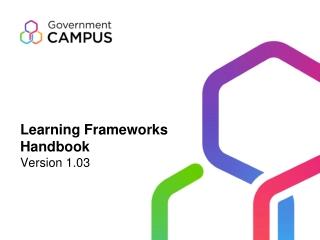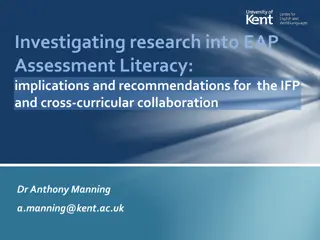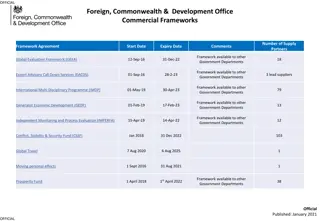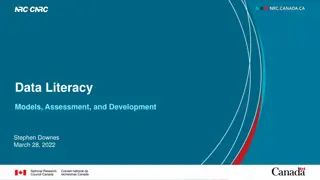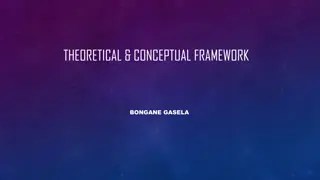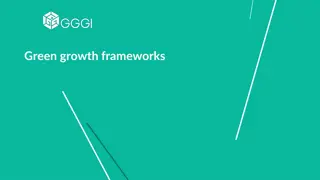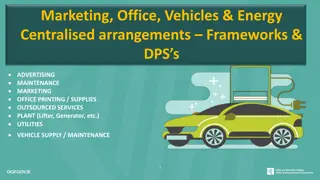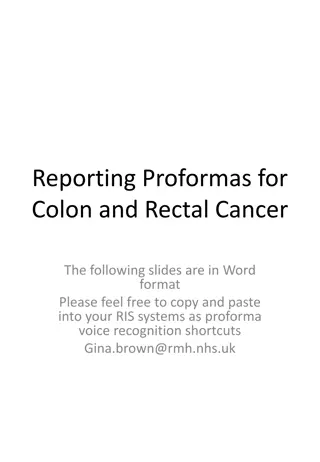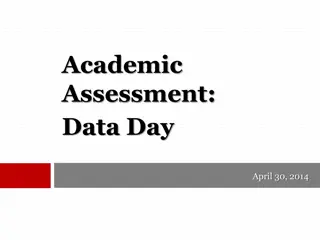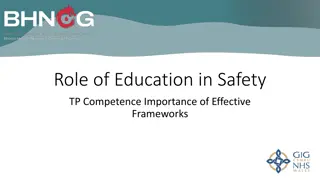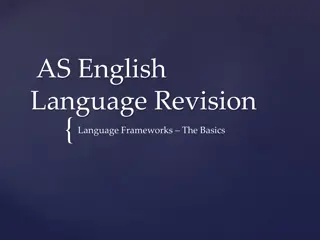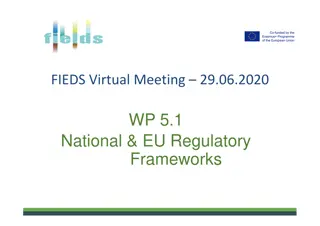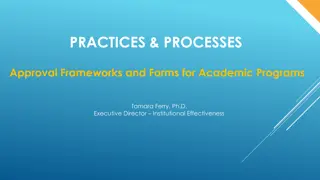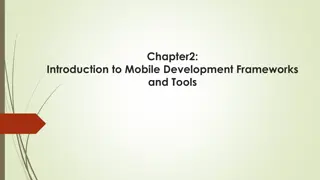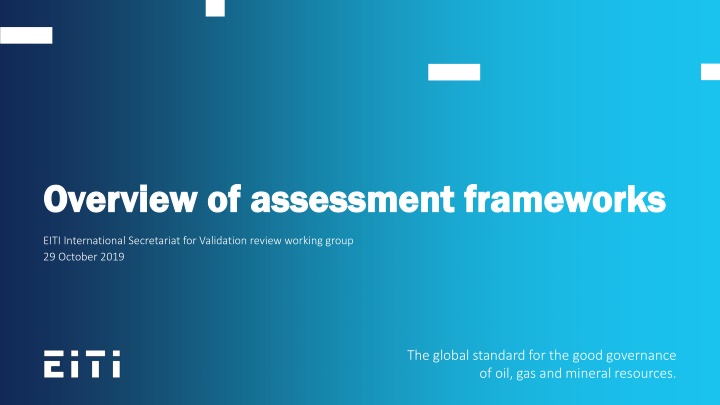
Assessment Frameworks Overview and Findings
Assessment frameworks play a vital role in ensuring good governance of oil, gas, and mineral resources. This content provides insights into various frameworks, reviews, and the summary of findings related to assessment processes. Explore the African Peer Review Mechanism, Clean Development Mechanism, Financial Action Task Force, and more.
Download Presentation

Please find below an Image/Link to download the presentation.
The content on the website is provided AS IS for your information and personal use only. It may not be sold, licensed, or shared on other websites without obtaining consent from the author. If you encounter any issues during the download, it is possible that the publisher has removed the file from their server.
You are allowed to download the files provided on this website for personal or commercial use, subject to the condition that they are used lawfully. All files are the property of their respective owners.
The content on the website is provided AS IS for your information and personal use only. It may not be sold, licensed, or shared on other websites without obtaining consent from the author.
E N D
Presentation Transcript
Overview Overview of of assessment assessment frameworks frameworks EITI International Secretariat for Validation review working group 29 October 2019 The global standard for the good governance of oil, gas and mineral resources.
Assessment frameworks included 1. African Peer Review Mechanism 2. Clean Development Mechanism 3. Financial Action Task Force 4. Global Reporting Initiative 5. ISO Standards 6. OECD Global Forum 7. Open Government Partnership Independent Reporting Mechanism 8. Resource Governance Index 9. Universal Periodic Review
Summary of findings It is typical for review processes to be extensive and lengthy. The more detailed the underlying standard is, the more detailed the reviews become. Self-assessments are a common feature (APRM, Global Forum, CDM). Many review mechanisms rely on peer reviews, with a secretariat providing support and a board approving the final report. This requires that all members are able to contribute experts. Other models include e.g. contracting country-specific researchers (OGP and RGI) or outsourcing compliance checks to accredited actors (ISO, CDM). Reviews focus to a varying degree on technical indicators vs. outcomes and impact. The purpose of the reviews varies. In some cases the focus is on learning through the review process (APRM, UPR), in others on the outcome of the assessment (Global Forum, FATF, RGI). Typically full compliance is not expected for the highest rating. Most review mechanisms lack effective measures to ensure that recommendations are followed up and gaps addressed. Stakeholder pressure and blacklisting (OECD, FATF) appear to be the most common consequences of poor performance.
African Peer Review Mechanism (APRM) 1/2 Member countries within the APRM (38) undertake self-monitoring in all aspects of their governance and socio- economic development. African Union (AU) stakeholders participate in the assessment of different branches of government, the private sector, civil society and the media. The APRM Review Process gives member states a space for national dialogue on governance and socio-economic indicators and an opportunity to build consensus on the way forward. Four thematic areas: Democracy and Political Governance, Economic Governance and Management, Corporate Governance, Broad-based Sustainable Socio-economic Development. Four types of country reviews: Base Review carried out immediately after a country becomes a member of the APRM Periodic Review every four years Requested Review requested by the member country itself outside the framework of mandated reviews A Review commissioned by the APR Forum when there are early signs of pending political and economic crisis. Links: https://www.aprm-au.org/ https://au.int/en/organs/aprm https://www.aprm-au.org/publications/objectives-standards-criteria-and-indicators/ http://www.aprmtoolkit.saiia.org.za/country-reports-and-experiences?start=40
African Peer Review Mechanism (APRM) 2/2 Five stages of peer review consultation: The APR Secretariat and the country under review consult on the process overview. The country creates a Focal Point to liaise with the Secretariat and provide it with relevant documents. The Secretariat prepares a background assessment. At the same time, the country under review independently completes the APR Self-Assessment Questionnaire, gathers inputs from civil society and drafts a paper outlining the nation s issues and a National Programme of Action (NPoA) with clear steps and deadlines on how it plans to conform to APRM codes and standards, the African Union Charter, and UN obligations. The Country Review Team that is set up writes a report outlining issues to be focused on during the review mission. The review mission visits the country under review and conducts broad-based consultations with government, officials, political parties, parliamentarians, and representatives of civil society organisations, and the private sector. The mission typically lasts two-and-a-half to three weeks. The APR Country Review Team drafts a report. For each area, there is an overview, implementation of standards and codes and assessment of performance on APRM objectives. This includes self-assessment, findings by the Country Review Team and recommendations by the APRM Panel. The peer review takes place at the level of the APR Forum, using the APR Panel s report on the team s findings as a basis. The APR Forum discusses these recommendations with the reviewed country s leadership. Within six months after the peer review, the published Country Review Report must be tabled in sub-regional institutions. The report is then made publicly available.
Clean Development Mechansim (CDM) 1/2 CDM is a feature of the Kyoto Protocol. To help countries meet their emission targets, and to encourage the private sector and developing countries to contribute to emission reduction efforts, negotiators of the Protocol included three market-based mechanisms - emissions trading, the clean development mechanism (CDM) and Joint Implementation (JI). The CDM allows emission-reduction projects in developing countries to earn certified emission reduction (CER) credits, each equivalent to one tonne of CO2. The CDM is supervised by the CDM Executive Board (CDM EB) under the guidance of the Conference of the Parties (COP/MOP) of the United Nations Framework Convention on Climate Change (UNFCCC). Using methodologies approved by the CDM Executive Board (EB), the applicant industrialised country must make the case that the carbon project would not have happened anyway (establishing additionality), and must establish a baseline estimating the future emissions in absence of the registered project. The case is then validated by a third party agency, called a Designated Operational Entity (DOE), to ensure the project results in real, measurable, and long-term emission reductions. The EB then decides whether or not to register (approve) the project. Any proposed CDM project has to use an approved baseline and monitoring methodology to be validated, approved and registered. Baseline Methodology will set steps to determine the baseline within certain applicability conditions whilst monitoring methodology will set specific steps to determine monitoring parameters.
Clean Development Mechansim (CDM) 2/2 A designated operational entity (DOE) is an independent auditor accredited by the CDM Executive Board (CDM EB) to validate project proposals or verify whether implemented projects have achieved planned greenhouse gas emission reductions. The two key functions of DOEs are: Validation: Assessing whether a project proposal meets the eligibility requirements and subsequently request registration of the project by the CDM EB. Verification/certification: Verifying emission reductions from a project, certify as appropriate, and recommend to the CDM EB the amount of Certified Emission Reductions (CERs) that should be issued. Usually, for large scale projects, a DOE may only conduct either validation or verification of the same project. However, upon request, the CDM EB may allow a single DOE to perform both functions (validation and verification/certification). Links: https://cdm.unfccc.int/Reference/Procedures/index.html https://www.adb.org/sites/default/files/institutional-document/185390/mrv-manual-cdm-projects.pdf https://cdm.unfccc.int/DOE/index.html https://en.wikipedia.org/wiki/Clean_Development_Mechanism
ISO Standards ISO develops standards (such as anti-bribery management systems, ISO 37001) but is not involved in their certification, and does not issue certificates. This is performed by external certification bodies. However ISO's Committee on Conformity Assessment (CASCO) has produced a number of standards related to the certification process, which are used by certification bodies. International accreditation bodies provide accreditation to certifying organisations. Complaints regarding certification can be directed to ISO. Links https://www.iso.org/certification.html https://www.iso.org/committee/54998/x/catalogue/p/1/u/0/w/0/d/0
Financial Action Task Force (FATF) 1/2 The FATF conducts peer reviews of each member on an ongoing basis to assess levels of implementation of the FATF Recommendations, providing an in-depth description and analysis of each country s system for preventing criminal abuse of the financial system. In practice, the reviews are often coordinated by FATF-style regional bodies (FSRBs). Reviews assess technical compliance, i.e. whether the necessary laws, regulations or other required measures are in force and effect, and whether the supporting institutional framework is in place. The effectiveness component will assess whether the AML/CFT systems are working, and the extent to which the country is achieving the defined set of 11 outcomes. Together, the assessments of both technical compliance and effectiveness will present an integrated analysis of the extent to which the country is compliant with the FATF Standards and how successful it is in maintaining a strong AML/CFT system, as required by the FATF Recommendations. The onus is on countries to demonstrate compliance and effectiveness. The assessment team will usually consist of 5-6 expert assessors (comprising at least one legal, financial and law enforcement expert), principally drawn from FATF members, and will be supported by members of the FATF Secretariat.
Financial Action Task Force (FATF) 2/2 The assessors visit the country and produce an independent report. The FATF Secretariat supports in ensuring quality and consistency and also supports the assessed jurisdiction. The assessed country provides comments. Assessors start with considering context-specific risks and the materiality of issues. The relevance of the criteria in the context is considered when determining the rating. FATF s Evaluations and Compliance Group and Plenary review the report and adopt it on a no objection basis. All members and observers have 2 weeks to raise concerns. Reports provide recommendations. FATF lists countries that are high-risk and require monitoring. High-risk jurisdictions are reviewed by FATF s International Co-operation Review Group. Links http://www.fatf-gafi.org/faq/mutualevaluations/ http://www.fatf-gafi.org/media/fatf/documents/methodology/FATF%20Methodology%2022%20Feb%202013.pdf http://www.fatf-gafi.org/media/fatf/documents/methodology/FATF-4th-Round-Procedures.pdf https://www.fatf-gafi.org/publications/high-riskandnon-cooperativejurisdictions/more/more-on-high-risk-and-non-cooperative- jurisdictions.html?hf=10&b=0&s=desc(fatf_releasedate)
FATF effectiveness ratings Assessors should clearly explain the basis for their judgement, e.g., problems or weaknesses which they believe are responsible for a lack of effectiveness; the core issues and the information which they considered to be most significant; the way in which they understood data and other indicators; and the weight they gave to different aspects of the assessment. Assessors should also identify any areas of particular strength or examples of good practice.
Global Reporting Initiative (GRI) Corporate sustainability reporting standards developed through a multi-stakeholder approach. General disclosures that apply to all companies + topic-specific standards (environmental, social and economic) based on company s materiality assessment. Includes required and recommended disclosures. Management approach recommends external assurances, but not complusory. GRI does not assess whether disclosures comply with standards, but it provides support in reporting (at a cost). Relies largely on stakeholder oversight. Links: https://www.globalreporting.org/standards/questions-and-feedback/writing-a-report-in-accordance-with-the-standards/
OECD Global Forum 1/2 The Global Forum conducts peer reviews of its member jurisdictions' ability to co-operate with other tax administrations in accordance with the internationally agreed standard. Reviews assess the legal and practical implementation of the standard. Assessment teams usually consist of two expert assessors coordinated by one member of the Global Forum Secretariat. Expert assessors will be drawn primarily from Peer Review Group (PRG) members, should be public officials, have relevant expertise and be free from conflicts of interest. Other member jurisdictions can provide input through a peer questionnaire. The assessment team reviews input and prepares a questionnaire for the assessed jurisdiction. Secretariat drafts the report after on-site visit. Expert assessors and the jurisdiction provide comments. PRG reviews and approves the report. Finally, it is adopted by the Global Forum. The reviews are inter-governmental, and non-governmental stakeholders are not involved. Additional Fast-Track Procedure to demonstrate progress. Links http://www.oecd.org/tax/transparency/exchange-of-information-on-request/peer-review/ http://www.oecd.org/tax/transparency/about-the-global-forum/publications/revised-methodology.pdf http://www.oecd.org/tax/transparency/fast-track-review-procedure-frequently-asked-questions.pdf
OECD Global Forum 2/2 Four possible ratings: Compliant: the jurisdiction s EOIR practice is effective. This does not demand perfection. A jurisdiction can be rated overall Compliant with the standard even though some recommendations are issued, but there should be no material deficiencies identified. Largely compliant: The standard is implemented to a large extent but some improvements are needed. The deficiencies identified are material but have limited impact on EOIR. Partially Compliant: The standard is only partly implemented. At least one material deficiency has been identified which has had, or which is likely to have, a significant effect on EOIR in practice. Non-Compliant: Fundamental deficiencies are identified in the implementation of the standard. Links: http://www.oecd.org/tax/transparency/exchange-of-information-on-request/ratings/#d.en.342263
Open Government Partnership (OGP) The Independent Reporting Mechanism (IRM) produces annual independent progress reports for each country participating in OGP. The progress reports assess governments on the development and implementation of OGP action plans, progress in fulfilling open government principles, and make technical recommendations for improvements. Reports focus on (1) process for agreeing commitments, and (2) the specificity and measurability of commitments, their relevance, potential impacts and implementation. The reports are to provide a snapshot view of the National Action Plan development and implementation. Conducted by independent researchers contracted by OGP s IRM staff. The IRM is an independent body within OGP. An International Expert Panel (IEP) oversees the IRM s work and the quality of review reports. If a country gets a negative report for three years and does not live up to the recommendations, is taking actions that undermine the values and principles of OGP, or is sliding back on the eligibility criteria, then membership may be discussed or ended, and a country could be expelled. Links https://www.opengovpartnership.org/process/accountability/independent-reporting-mechanism/ https://www.opengovpartnership.org/open-data/ https://www.opengovpartnership.org/wp-content/uploads/2018/03/IRM-Review-Final-Report_Blomeyer-Sanz_20171212.pdf
Resource Governance Index 2017 RGI measures the quality of governance in the oil, gas and mining sectors in 81 countries. By Natural Resource Governance Institute. For each country, summary score and subcomponent scores (maximum score 100). 89 researchers answered questionnaire, 89 peer reviewers validated the responses. NRGI staff reviewed the responses. Each answer was given a numeric value between 0 and 100. In total, 149 questions. Links: https://resourcegovernanceindex.org/about/methodology
Universal Periodic Review (UPR) 1/2 Periodic review of human rights record of all UN member states. The reviews are conducted by the UPR Working Group, which consists of the 47 members of the Council; however any UN Member State can take part in the discussion/dialogue with the reviewed states. Each state review is assisted by groups of three states, known as troikas , who serve as rapporteurs. The documents on which the reviews are based are: 1) information provided by the state under review,; 2) information contained in the reports of independent human rights experts and groups; 3) information from other stakeholders including national human rights institutions and non-governmental organisations. Interactive discussion between the state under review and other UN Member States at a Working Group meeting. Any UN Member State can pose questions, comments and/or make recommendations to the states under review. The troikas may group issues or questions to be shared with the state under review.
Universal Periodic Review (UPR) 2/2 Following the review by the Working Group, a report is prepared by the troika with the involvement of the State under review and assistance from the OHCHR. This report, referred to as the outcome report , consists of the questions, comments and recommendations made by states to the country under review, as well as the responses by the reviewed State. The reviewed state has the opportunity to make preliminary comments on the recommendations choosing to either accept or note them. Both accepted and noted recommendations are included in the report. The report has to be adopted at a plenary session of the Human Rights Council. The state has the primary responsibility to implement the recommendations contained in the final outcome. During the second review the state is expected to provide information on what they have been doing to implement the recommendations made during the first review as well as on any developments in the field of human rights. The Human Rights Council will decide on the measures it would need to take in case of persistent non-co-operation by a state with the UPR. Links https://www.ohchr.org/en/hrbodies/upr/pages/uprmain.aspx https://www.ohchr.org/en/hrbodies/upr/pages/basicfacts.aspx

